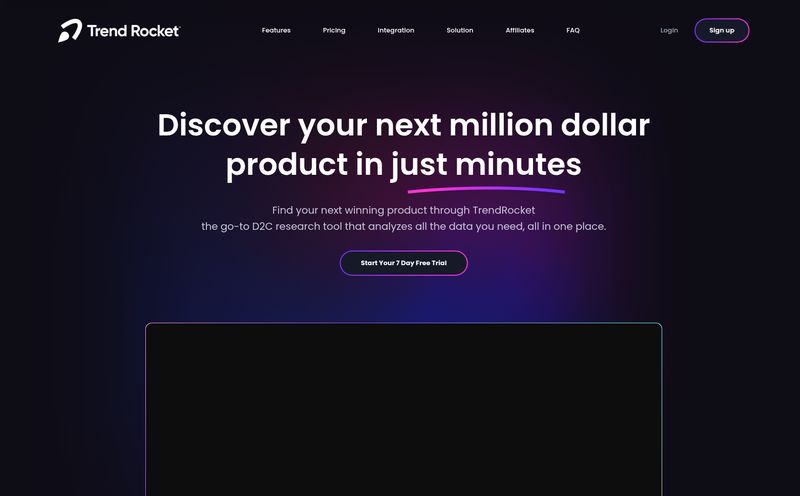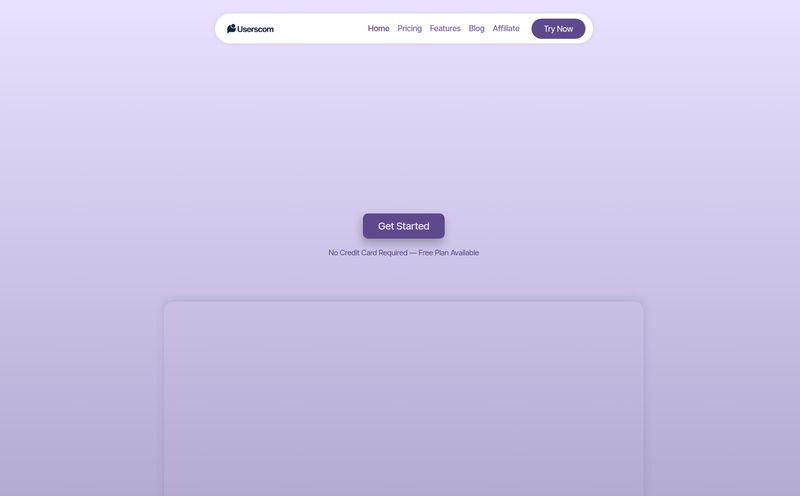When was the last time you were genuinely excited to fill out a customer feedback survey? Yeah, I thought so. For me, it ranks somewhere between updating my computer's terms of service and discovering my favorite coffee shop is out of oat milk. It's a chore. And as business owners and marketers, we feel that pain on the other side, too. We send out thousands of requests, hoping for a handful of lukewarm responses. It's a broken system.
We spend our days obsessing over traffic, CPC, and conversion rates, but when it comes to understanding what our customers actually think, we often resort to a method that feels about as modern as a fax machine. We're practically begging for data, and the data we get is often… well, sparse.
So, when I hear about a tool that wants to flip this whole tired process on its head, my ears perk up. The tool in question is Tabnam, and it's not just another form builder. It's built on a pretty compelling idea: what if getting feedback was just a conversation?
So, What Exactly is Tabnam?
At its core, Tabnam is an AI-powered platform designed to gather and analyze customer feedback. But the 'how' is what's interesting. Instead of sending a link to a boring, multi-page survey, Tabnam deploys an AI bot to chat with your customers conversationally. Think text message, WhatsApp, or other messaging platforms. It feels less like an interrogation and more like a quick, helpful chat.
But it doesn't stop there. The real magic, for a data nerd like me, is its ability to act as a central hub. It doesn't just collect feedback from its own conversations; it pulls it in from all the other places your customers are already talking. We're talking Zendesk tickets, Discord channels, app store reviews, you name it. It then uses AI to sift through this mountain of qualitative data, find the patterns, and tell you what actually matters. Pretty neat, huh?

Visit Tabnam
Why Traditional Feedback is a Sinking Ship
I've been in the SEO and digital marketing game for years, and I've seen countless companies with amazing products fail to connect with their audience. They have all the traffic in the world but no real clue what people are saying post-purchase. The classic survey is partly to blame.
Survey fatigue is a real phenomenon. A 2019 study I remember reading from Forbes touched on this, highlighting just how overwhelmed consumers are. We're asked for feedback on everything from a pack of gum to a new car. The result? Abysmal response rates. The people who do respond are often on the extreme ends of the spectrum—either they're absolutely furious or they're your biggest fans. The massive, insightful middle ground? Crickets.
Then there's the analysis problem. Let's say you're diligent. You have feedback coming in from your support desk, your social media DMs, a suggestion box on your site, and maybe even a lively Discord community. Trying to manually consolidate and make sense of all that is like trying to knit a sweater with spaghetti. It's messy, time-consuming, and you'll probably miss the most important threads. It’s a full-time job in itself, and most teams just don't have the bandwidth.
How Tabnam Aims to Fix This Mess
This is where I get genuinely excited about the potential. Tabnam isn't just a minor upgrade; it's a different way of thinking about the entire feedback loop.
Conversations, Not Interrogations
The first big win is the conversational approach. Sending a text that says, "Hey, got a sec to help us improve? What's one thing we could do better?" is so much more personal and less demanding than a 10-question survey. It meets customers where they are, on the devices they use all day. This frictionless process is almost guaranteed to get you higher response rates. It’s the difference between asking a friend for a favor and sending them a formal subpoena. One gets a friendly reply; the other gets ignored.
Your All-in-One Feedback Hub
For me, this is the killer feature. The aggregation. The fact that Tabnam can connect to Zendesk, Intercom, Discord, and other sources is a game-changer. It means ALL your customer feedback, both solicited (from their bot) and unsolicited (from other platforms), lives in one place. No more switching between ten different tabs. No more copy-pasting comments into a spreadsheet at 2 AM. It creates a single source of truth for the voice of your customer. That alone is worth its weight in gold.
Letting the AI Do the Heavy Lifting
Once you have all that data, Tabnam’s AI gets to work. It’s not just counting keywords. It's analyzing sentiment, identifying recurring themes, and even prioritizing complaints. Imagine your dashboard automatically telling you, "Hey, 25% of the negative feedback this week mentions slow shipping times." That's not just data; that's an actionable insight. It’s a bright, flashing arrow pointing directly at what you need to fix. This automated prioritization saves hundreds of person-hours and helps you focus on the fires that are actually burning brightest.
The Good, The Bad, and The AI
No tool is perfect, of course. Based on my analysis, here's my honest take. The big advantages are clear: you’re likely to get more responses and the insights are genuinely actionable because the AI is doing the synthesis for you. It turns a jumble of customer opinions into a clear to-do list. The frictionless nature for the customer is a massive plus, and the multi-source integration is, as I said, a killer feature.
However, you do have to place a certain amount of trust in the AI. How accurate is its analysis? That's a fair question for any AI-driven platform. There's also the initial setup. Integrating multiple platforms can sometimes have its own little quirks and complexities, so you should probably budget some time for configuration. It's not a magic wand you can wave and have everything work instantly. But then again, what is?
What's the Damage? A Look at Tabnam's Pricing
And now for the question on everyones mind: how much does it cost? Well, here’s where my research hit a funny little snag. When I went to find their official pricing page to give you the details… I was met with a stark "403 Forbidden" error. The irony is not lost on me—a tool designed to improve communication giving me the digital silent treatment!
So, unfortunately, I can't give you a neat little table with tiers and prices. It seems they are either in the process of updating it, or they prefer a custom-quote approach. Your best bet is to head over to their website directly and reach out. Don’t be surprised if you have to book a demo to get the numbers, which is pretty common for B2B SaaS in this space.
Frequently Asked Questions about Tabnam
What is Tabnam in simple terms?
Tabnam is an AI tool that talks to your customers via text or WhatsApp to get their feedback. It also pulls in feedback from other places like support tickets and social media and uses AI to analyze it all for you.
How is Tabnam different from something like SurveyMonkey?
SurveyMonkey is a traditional survey builder. Tabnam is a conversational AI. Instead of sending a static form, Tabnam has a two-way chat. It also automatically analyzes qualitative feedback from many sources, which is a step beyond what most form builders do.
Can Tabnam integrate with the tools my team already uses?
Yes, one of its main features is integrating with popular platforms like Zendesk and Discord to aggregate feedback. You'd need to check their specific list of integrations to ensure compatibility with your entire tech stack.
Is Tabnam suitable for small businesses?
It seems so. While the enterprise applications are obvious, any business struggling with low survey response rates or feeling overwhelmed by feedback from different channels could benefit. The final decider would, of course, be the pricing, which isn't publically available.
Does Tabnam's AI replace human analysis completely?
Not at all. I see it as a powerful assistant. The AI does the initial, heavy-duty sorting and pattern recognition, which frees up your team to focus on the strategic implications of the feedback, rather than the manual task of collecting it.
Is the AI feedback collection intrusive for customers?
It’s designed to be the opposite. Because it uses familiar channels like SMS and WhatsApp and keeps the conversation short and natural, it's generally considered less intrusive than an email with a link to a long, formal survey.
My Final Thoughts on Tabnam
Look, the way we've been gathering customer feedback is archaic. It’s a numbers game where the house (of survey fatigue) always wins. Tools like Tabnam represent a necessary shift in thinking. They move us from static forms to dynamic conversations, from manual drudgery to intelligent automation.
While I couldn't get my hands on the pricing, the concept itself is incredibly sound. If you're a product manager drowning in feature requests or a marketer trying to genuinely understand your customer's voice, this is the kind of technology you should be paying attention to. It might just be the thing that finally makes customer feedback a process you look forward to, instead of one you dread. And that, in itself, is a huge win.
References and Sources
- Forbes Communications Council: Why No One Is Taking Your Surveys And What To Do About It
- SuperOffice: 9 Ways to Collect Customer Feedback



